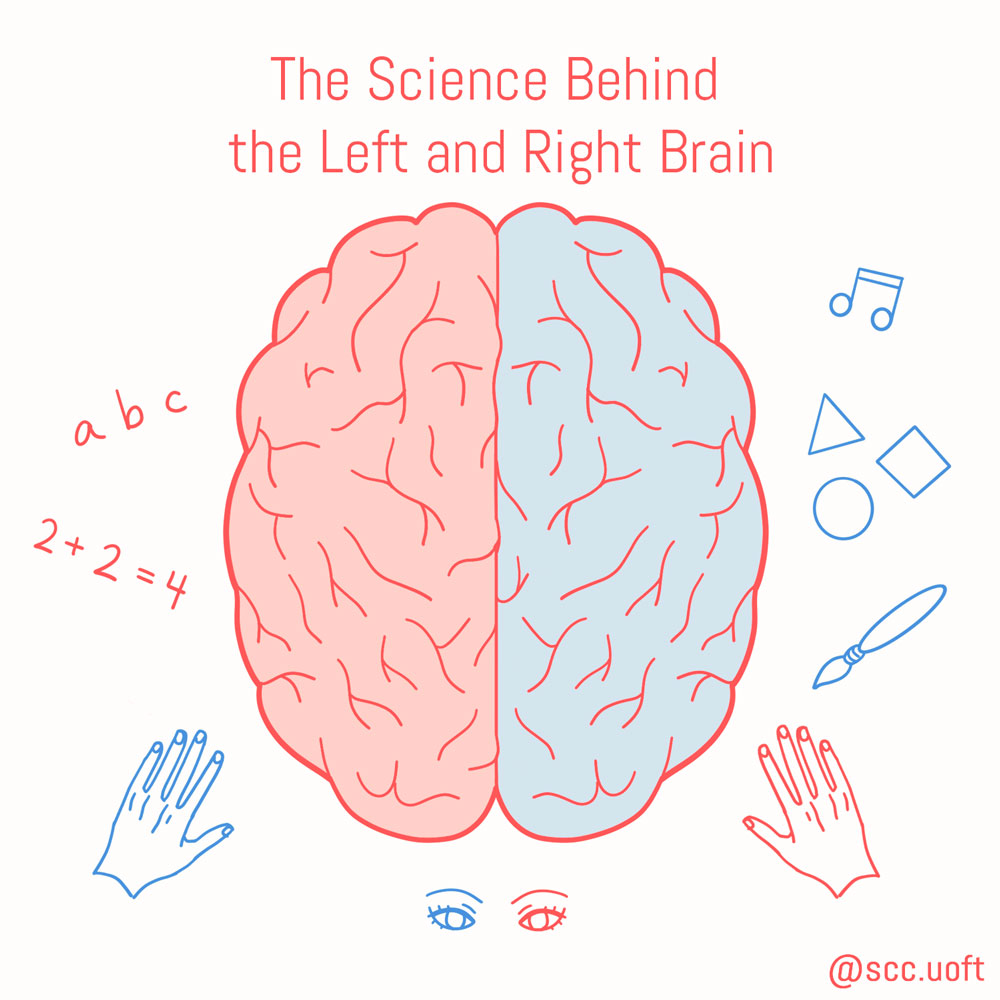
Written by Peter Hong
Illustrated by Anna Tram
Through social media, TV, and online quizzes; almost everyone has heard about people being “left-brained” or “right-brained.” This is based on the idea that people who are more logical and methodical are left-brained, while those who are more spatial and creative are right brained. You may have even heard the term “golden brain” used to refer to people who use both sides of their brain equally. This is very similar to how most people are either right handed or left handed, and some people are even ambidextrous!
In reality, most of these traits do associate with one side of the brain! This comes from localization of function, or lateralization, in the brain. The brain is divided into two hemispheres, which are able to communicate with each other through a bundle of nerves called the corpus callosum. By studying people who had their corpus callosum severed to treat epilepsy, scientists were able to figure out that each side of the brain processes certain information that the other does not. What was shocking to neuroscientists at the time was that splitting apart the two hemispheres also split the brain into two separate minds! This didn’t actually mean that there was two people in one body, but it certainly appeared that way when one of a patient’s hands would start competing with the other while carrying out tasks.
In one test, a split-brain patient’s right hand, which is controlled by the left hemisphere, couldn’t seem to get a set of blocks to match a pattern shown on a flashcard. However, his left hand, which is controlled by the right hemisphere, had no trouble performing the task at all. It even tried to take over and help the right hand! In another test, the split-brain patient couldn’t name everyday objects shown in their left visual field. However, when asked to do the same for objects in their right visual field, they could do it with ease! It turns out that the right and left visual field are processed in different hemispheres of the brain: the right visual field is processed in the left hemisphere, and the left visual field is processed in the right. Split-brain tests like these have led to generalizations that are very widespread in today’s pop-culture, like the idea that the left hemisphere processes language, and the right handles spatial functions.
Unfortunately for the quiz-makers at Buzzfeed, this is where the truth behind left-brain and right-brain dominance ends. As incredible as the science behind the hemispheres is, it has been blown out of proportion and exaggerated like many other internet myths. As the “left-brain right-brain” idea became more and more popular, the details of it seemed to get fuzzier and fuzzier. In reality, brain lateralization does not mean you are using one side of the brain more than the other during most activities. A recent study from the University of Utah used modern brain imaging technology to confirm that there really aren’t any signs of one hemisphere dominating the other. While it’s true that you may predominantly use one side of your brain during certain cognitive tasks, in most cases you need to use both!
Although you’re probably not left brained or right brained, you do have your own strengths and weaknesses that set you apart from everyone else. So instead of trying to figure which side of your brain you use the most, perhaps do some quizzes to figure out how to play to your strengths and tackle your weaknesses. If you work hard enough, there’s no telling what both sides of your brain can do!
Sources:
- https://www.healthline.com/health/left-brain-vs-right-brain
- https://www.health.harvard.edu/blog/right-brainleft-brain-right-2017082512222
- https://www.britannica.com/story/are-there-really-right-brained-and-left-brained-people
- https://journals.plos.org/plosone/article?id=10.1371/journal.pone.0071275
- https://www.verywellmind.com/left-brain-vs-right-brain-2795005
- https://www.pnas.org/content/111/51/18097